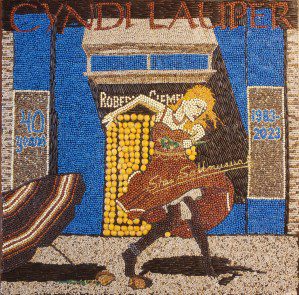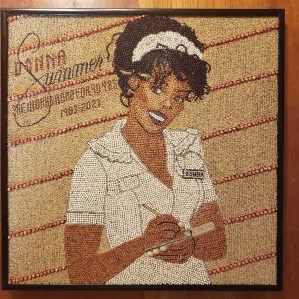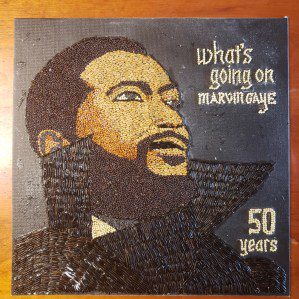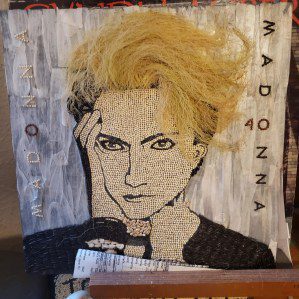
Cyndi Lauper
Marta Shore
 Posted On
Posted On
While there’s no shortage of fans celebrating their musical favorites digitally, tangible tributes – from friendship bracelets to Etsy creations – seem to be making a comeback lately. With that in mind, a Midwestern biostatistics teacher has found a particularly novel way to honor her musical icons while going against the digital grain.
But be warned: This fan art is a bit seedy.
Since 2021, Marta Shore, a biostatistics lecturer at the University of Minnesota, has spent her free time painstakingly recreating classic album artwork using everything from quinoa to chia seeds to flax to barley to wild rice. It’s called crop art, and at the 2023 Minnesota State Fair, Shore displayed three plant-based recreations of 1983 pop classics: Madonna’s self-titled debut album, Donna Summer’s She Works Hard for the Money and Cyndi Lauper’s She’s So Unusual.
“1983 was the year I really started listening to music outside of what my parents would listen to,” Shore says. “I still have a lot of these [albums] on vinyl.”
Crop art has become more than just a hobby for the university lecturer – it’s helped her connect with her students, too. When classes went virtual during the pandemic, Shore noticed that her students perked up when she made an offhand comment about her unusual hobby. “They just loved seeing me make and share something about my life besides statistics,” she says. Weekly updates about her Megan Rapinoe crop art helped them to “feel more connected to me and each other” during lockdown, she opines.
Soon, Shore invited her students – people studying to be epidemiologists, pharmacists, health policy wonks and more – to vote on what she should create next. The winner was RuPaul’s Drag Race winner Bianca Del Rio uttering her catchphrase “Not today, Satan,” which she then rendered in all organic plant material. “Sixty percent of my students wanted that one,” Shore, ever the statistician, recalls. “And [after that] they were even more invested.”
The benefits went beyond getting students to pay more attention. Several of them reached out to Shore to share that she inspired them to dust off their own creative outlets, helping their mental health in the process.

Cyndi Lauper
Marta Shore
That’s certainly a benefit the statistician can relate to. While Shore says formal meditation doesn’t work for her, she can disconnect while doing crop art, which requires “just enough attention that my mind doesn’t wander, and just enough physical activity that I don’t get antsy.”
Sometimes she puts on headphones and listens to the album whose art she’s recreating; other times, she puts on a “comfort show,” like Parks and Recreation or The Other Two, and zones out while affixing bits of oat, quinoa and corn to a spray-painted board.
It began in 2015 when her daughter, then a kindergartener, was invited over to a friend’s house to try out the agriculture-centric folk art. Shore struck up a friendship with the girl’s mother, Jill, and learned the ropes herself. Eventually, she submitted a piece for inclusion in the Minnesota State Fair, the second-largest state fair in America, which features an annual crop art wall in the Agriculture Horticulture Building.
“My first piece was not great, but it got up on the wall, which made me feel really good,” she says. “I’d never really made anything artistic before. I mean, I’m a little math nerd.”
Buoyed by the success, Shore kept gluing seeds to boards, growing as an artist and learning about textures and perspective (she says her older daughter, who took a summer course at Pratt Institute in Brooklyn, helped her figure out how to render the shadows on the cover of Lauper’s debut). “I print out the image from the album and trace around the edges,” Shore, who now teaches a crop art course on the side, explains of her go-to starting point. “White chia and white quinoa are really good for white; wild rice, canola and poppy are really good for black.”
“There’s a fair amount of trial and error as well,” she says. “I was originally going to make Madonna’s hair out of white quinoa, which I did and hated. Then I was like, ‘Oh, corn silk looks like bleached hair. Maybe I’ll try that instead.’”
She estimates that “for each piece, I do rip up 20 to 30 percent of it,” with her crop art pieces typically requiring 40 to 50 hours of work spread out over the year. “Donna Summer took me by far the longest because for the yellow background, that seed actually comes in about six different colors. So I picked out all the yellow.” She laughs. “My husband had thoughts. ‘Do you really need to go to this extreme?’”
But for her, the meditative activity isn’t an extreme at all. “I just love Donna Summer so much that there was joy in doing it. It felt like a labor of love.”

Donna Summer
Marta Shore
After each Minnesota State Fair, some of the crop art pieces find a permanent home in her office (including her 2021 recreation of Marvin Gaye’s What’s Going On album, which won fourth place at the fair in 2021), while others are given away or repurposed for future projects.
Shore is already prepping for the 2024 Minnesota State Fair, working on a recreation of Dolly Parton’s 1974 album Jolene — which she calls “one of the most important albums ever released” — while soliciting her students to vote on which Dolly quotes will accompany the album art. (Given that LP’s yellow-heavy background, let’s hope she finds a seed that doesn’t require hours upon hours of sorting). And considering that next year marks the 40th anniversary of an album famously associated with the Minneapolis venue First Avenue, it’s a given that the Minnesota university educator will be tackling Prince’s Purple Rain.
“It’s a busy album cover, for sure,” she says, clearly excited by the challenge. “I’m going to try using dried flowers on the sides. There’s a lot of smoke rising [in the cover photo]. I’m already thinking about how I’m going to do that. With seeds? With some sort of plant material over a background? I haven’t figure it all out yet.
“[With crop art] you get to do your meditation and produce this cool thing that you can show people,” she continues. “You have to do it because you really love it. So when I do it, I try to choose things I really love.”

Marvin Gaye
Marta Shore

Madonna
Marta Shore